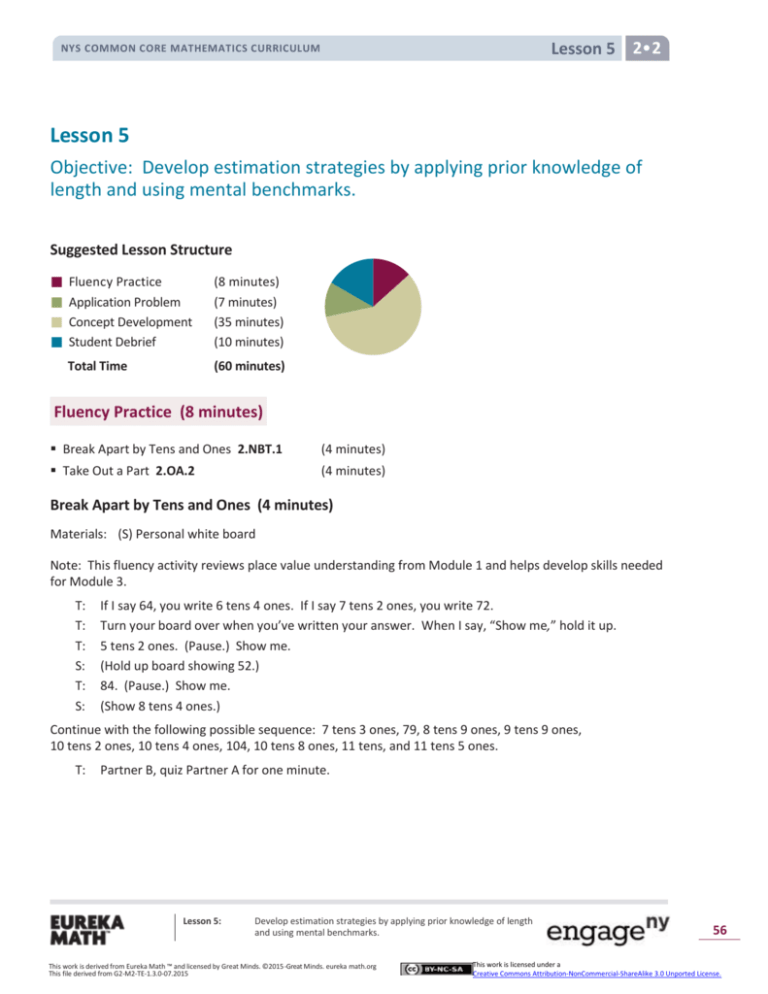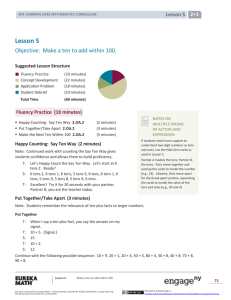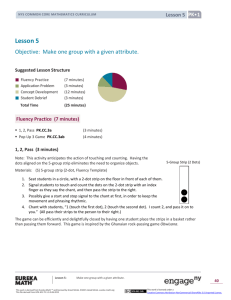Lesson 5 - EngageNY
advertisement

Lesson 5 2 2 NYS COMMON CORE MATHEMATICS CURRICULUM Lesson 5 Objective: Develop estimation strategies by applying prior knowledge of length and using mental benchmarks. Suggested Lesson Structure Fluency Practice Application Problem Concept Development Student Debrief Total Time (8 minutes) (7 minutes) (35 minutes) (10 minutes) (60 minutes) Fluency Practice (8 minutes) Break Apart by Tens and Ones 2.NBT.1 (4 minutes) Take Out a Part 2.OA.2 (4 minutes) Break Apart by Tens and Ones (4 minutes) Materials: (S) Personal white board Note: This fluency activity reviews place value understanding from Module 1 and helps develop skills needed for Module 3. T: T: T: S: T: S: If I say 64, you write 6 tens 4 ones. If I say 7 tens 2 ones, you write 72. Turn your board over when you’ve written your answer. When I say, “Show me,” hold it up. 5 tens 2 ones. (Pause.) Show me. (Hold up board showing 52.) 84. (Pause.) Show me. (Show 8 tens 4 ones.) Continue with the following possible sequence: 7 tens 3 ones, 79, 8 tens 9 ones, 9 tens 9 ones, 10 tens 2 ones, 10 tens 4 ones, 104, 10 tens 8 ones, 11 tens, and 11 tens 5 ones. T: Partner B, quiz Partner A for one minute. Lesson 5: Develop estimation strategies by applying prior knowledge of length and using mental benchmarks. This work is derived from Eureka Math ™ and licensed by Great Minds. ©2015 -Great Minds. eureka math.org This file derived from G2-M2-TE-1.3.0-07.2015 56 This work is licensed under a Creative Commons Attribution-NonCommercial-ShareAlike 3.0 Unported License. Lesson 5 2 2 NYS COMMON CORE MATHEMATICS CURRICULUM Take Out a Part (4 minutes) Note: In this activity, students build fluency with decomposing a whole, which allows them to use the make a ten strategy with larger numbers (e.g., 80 + 50 = 80 + 20 + 30). T: T: T: S: T: S: T: T: T: S: T: S: Let’s take out 2 tens from each number. I say 5 tens. You say, 2 tens + 3 tens = 5 tens. 5 tens. 2 tens + 3 tens = 5 tens. 7 tens. 2 tens + 5 tens = 7 tens. Let’s take out 20 from each number. I say 50. You say, 20 + 30 = 50. 50. 20 + 30 = 50. 70. 20 + 50 = 70. Continue with the following possible sequence: 83, 52, 97, 100, 105, 110, and 120. T: T: S: Now, let’s take out 40. If I say 60, you say 40 + 20 = 60. 50. Wait for the signal. 40 + 10 = 50. Continue with the following possible sequence: 70, 75, 81, and 87. Application Problem (7 minutes) Ethan has 8 fewer playing cards than Tristan. Tristan has 50 playing cards. How many playing cards does Ethan have? Note: This compare with smaller unknown problem uses the word fewer, which probably will suggest subtraction to students. The numbers were purposely chosen so students have the opportunity to use the take from ten strategy to solve. Lesson 5: Develop estimation strategies by applying prior knowledge of length and using mental benchmarks. This work is derived from Eureka Math ™ and licensed by Great Minds. ©2015 -Great Minds. eureka math.org This file derived from G2-M2-TE-1.3.0-07.2015 57 This work is licensed under a Creative Commons Attribution-NonCommercial-ShareAlike 3.0 Unported License. Lesson 5 2 2 NYS COMMON CORE MATHEMATICS CURRICULUM Concept Development (35 minutes) Materials: (T) Meter stick (displayed horizontally for student reference), three-ring binder (S) 1 unused unsharpened pencil, 1 centimeter cube, centimeter ruler from Lesson 3, meter tape, 1 wedge eraser T: S: T: S: T: S: T: S: T: MP.2 S: T: S: T: S: T: S: T: Put your pinky on your centimeter cube. Would you say it’s about the same width as the centimeter cube? Yes. How could you use your pinky to estimate length? I can tell how many times my pinky would fit into the space. I can put my pinky down as many times as I can and then count. Let’s try that. Use your pinky to estimate. About how long do you think the eraser is? Turn to your neighbor and share your estimate. About 6 centimeters. Let’s measure to see if your estimates are correct. (Use centimeter rulers to check estimates.) The distance from the floor to the doorknob is about 1 meter (verify by modeling). How does this help you estimate the length of your desk? My desk is about half the length from the floor to the doorknob, so it’s about 50 centimeters long. My desk is twice the length from the floor to the doorknob, so I think it’s about 2 meters long. Let’s measure to see which estimate is closer to the real measurement. (Use meter tapes to measure their desks.) Measure your pencil. How long is it? About 20 centimeters. Can that help you estimate the length of your math book? Estimate the length of your math book, and then measure it with your centimeter ruler to see how close you got. My math book is longer than the pencil, but not by much. They are almost the same. I think it’s about 23 centimeters. I think it’s 30 centimeters. Picture the meter stick in your mind. Estimate how many meters long the classroom board is. Lesson 5: NOTES ON MULTIPLE MEANS OF REPRESENTATION: In this lesson, students will be learning multiple benchmark measurements. To help all students remember the benchmarks, these techniques may prove useful: Partner language with visuals by posting pictures of the benchmarks. Instruct students to create a reference chart to keep track of the benchmarks as they learn them. They can later use this chart as a reference. NOTES ON MULTIPLE MEANS OF ENGAGEMENT: Use a chant to help students understand the conversion from meters to centimeters. Make gestures to accompany the chant. T: When I say meter, you say 100 centimeters. (Open arms wide, about the length of a meter.) T: Meter! (Open arms wide.) S: 100 centimeters! (Open arms wide.) This conversion is meant to support students’ estimations of the length of their desks. Develop estimation strategies by applying prior knowledge of length and using mental benchmarks. This work is derived from Eureka Math ™ and licensed by Great Minds. ©2015 -Great Minds. eureka math.org This file derived from G2-M2-TE-1.3.0-07.2015 58 This work is licensed under a Creative Commons Attribution-NonCommercial-ShareAlike 3.0 Unported License. Lesson 5 2 2 NYS COMMON CORE MATHEMATICS CURRICULUM S: T: T: S: T: MP.2 S: T: S: T: It looks like the board is a few meters long. I can fit more than one meter stick along the length of the NOTES ON board. I would say it is 2 meters long. To me, it’s MULTIPLE MEANS longer than 2 meters, but shorter than 3 meters. OF ACTION Let’s check our estimates. (Call on a volunteer to AND EXPRESSION: measure the board for the class.) Provide sufficient wait time to allow Now, look at this three-ring binder. What known students to process the connection measurement can we use to estimate the length? between mental benchmarks and It looks about the same as my ruler, so 30 centimeters. length of objects. Point to or hold visuals while speaking. So, let’s check and see if it is 30 centimeters. Ask students to explain how and why (Volunteer measures the three-ring binder.) they chose a specific mental It is. Now that we know this is 30 centimeters, what benchmark when estimating length. other lengths can we estimate with this information? The length of my science book. The length of the paper that goes inside the binder. All these measurements we use to estimate length are called mental benchmarks. The pencil is about 20 centimeters. Your pinky is about 1 centimeter. The three-ring binder is about 30 centimeters. And, the length from the doorknob to the floor is about 1 meter. You can use these benchmarks at any time by picturing them in your head to estimate the length of an object. Now, use your mental benchmarks to estimate length on your Problem Set. Check your estimates by measuring. Problem Set (10 minutes) Students should do their personal best to complete the Problem Set within the allotted 10 minutes. For some classes, it may be appropriate to modify the assignment by specifying which problems they work on first. Some problems do not specify a method for solving. Students should solve these problems using the RDW approach used for Application Problems. Note: Do not allow students to use their rulers to complete the Problem Set initially. Have them estimate the lengths first, and then, pull out their rulers and measure all the line segments at the very end. Otherwise, many students will measure, and then do the estimate. Lesson 5: Develop estimation strategies by applying prior knowledge of length and using mental benchmarks. This work is derived from Eureka Math ™ and licensed by Great Minds. ©2015 -Great Minds. eureka math.org This file derived from G2-M2-TE-1.3.0-07.2015 59 This work is licensed under a Creative Commons Attribution-NonCommercial-ShareAlike 3.0 Unported License. Lesson 5 2 2 NYS COMMON CORE MATHEMATICS CURRICULUM Student Debrief (10 minutes) Lesson Objective: Develop estimation strategies by applying prior knowledge of length and using mental benchmarks. The Student Debrief is intended to invite reflection and active processing of the total lesson experience. Invite students to review their solutions for the Problem Set. They should check work by comparing answers with a partner before going over answers as a class. Look for misconceptions or misunderstandings that can be addressed in the Debrief. Guide students in a conversation to debrief the Problem Set and process the lesson. Any combination of the questions below may be used to lead the discussion. Turn to your partner and compare your answers to Problems 1–5 in your Problem Set. Why is it possible to have different estimates? How can we check to see if our estimates are accurate? How many mental benchmarks can you name? (Draw students’ attention to Problem 6 on their Problem Set. Chart student responses for future reference.) How do mental benchmarks help us? When is a good time to use them? Exit Ticket (3 minutes) After the Student Debrief, instruct students to complete the Exit Ticket. A review of their work will help with assessing students’ understanding of the concepts that were presented in today’s lesson and planning more effectively for future lessons. The questions may be read aloud to the students. Lesson 5: Develop estimation strategies by applying prior knowledge of length and using mental benchmarks. This work is derived from Eureka Math ™ and licensed by Great Minds. ©2015 -Great Minds. eureka math.org This file derived from G2-M2-TE-1.3.0-07.2015 60 This work is licensed under a Creative Commons Attribution-NonCommercial-ShareAlike 3.0 Unported License. Lesson 5 Problem Set 2 2 2 NYS COMMON CORE MATHEMATICS CURRICULUM NYS COMMON CORE MATHEMATICS CURRICULUM Name Date First, estimate the length of each line in centimeters using mental benchmarks. Then, measure each line with a centimeter ruler to find the actual length. 1. a. Estimate: ______ cm b. Actual length: ______ cm a. Estimate: ______ cm b. Actual length: ______ cm a. Estimate: ______ cm b. Actual length: ______ cm a. Estimate: ______ cm b. Actual length: ______ cm a. Estimate: ______ cm b. Actual length: ______ cm 2. 3. 4. 5. Lesson 5: Develop estimation strategies by applying prior knowledge of length and using mental benchmarks. This work is derived from Eureka Math ™ and licensed by Great Minds. ©2015 -Great Minds. eureka math.org This file derived from G2-M2-TE-1.3.0-07.2015 61 This work is licensed under a Creative Commons Attribution-NonCommercial-ShareAlike 3.0 Unported License. NYS COMMON CORE MATHEMATICS CURRICULUM NYS COMMON CORE MATHEMATICS CURRICULUM Lesson 5 Problem Set 2 2 2 6. Circle the correct unit of measurement for each length estimate. a. The height of a door is about 2 (centimeters/meters) tall. What benchmark did you use to estimate? _______________ b. The length of a pen is about 10 (centimeters/meters) long. What benchmark did you use to estimate? _______________ c. The length of a car is about 4 (centimeters/meters) long. What benchmark did you use to estimate? _______________ d. The length of a bed is about 2 (centimeters/meters) long. What benchmark did you use to estimate? _______________ e. The length of a dinner plate is about 20 (centimeters/meters) long. What benchmark did you use to estimate? _______________ 7. Use an unsharpened pencil to estimate the length of 3 things in your desk. a. _____________________ is about _______ cm long. b. _____________________ is about _______ cm long. c. _____________________ is about _______ cm long. Lesson 5: Develop estimation strategies by applying prior knowledge of length and using mental benchmarks. This work is derived from Eureka Math ™ and licensed by Great Minds. ©2015 -Great Minds. eureka math.org This file derived from G2-M2-TE-1.3.0-07.2015 62 This work is licensed under a Creative Commons Attribution-NonCommercial-ShareAlike 3.0 Unported License. Lesson 5 Exit Ticket 2 2 NYS COMMON CORE MATHEMATICS CURRICULUM Name Date 1. Circle the most reasonable estimate for each object. a. Length of a push pin 1 cm or 1 m b. Length of a classroom door 100 cm or 2 m c. Length of a pair of student scissors 17 cm or 42 cm 2. Estimate the length of your desk. (Remember, the width of your pinky is about 1 cm.) My desk is about _____ cm long. 3. How does knowing that an unsharpened pencil is about 20 cm long help you estimate the length of your arm from your elbow to your wrist? __________________________________________________________ __________________________________________________________ __________________________________________________________ __________________________________________________________ Lesson 5: Develop estimation strategies by applying prior knowledge of length and using mental benchmarks. This work is derived from Eureka Math ™ and licensed by Great Minds. ©2015 -Great Minds. eureka math.org This file derived from G2-M2-TE-1.3.0-07.2015 63 This work is licensed under a Creative Commons Attribution-NonCommercial-ShareAlike 3.0 Unported License. Lesson 5 Homework 2 2 NYS COMMON CORE MATHEMATICS CURRICULUM Name Date 1. Name five things in your home that you would measure in meters. Estimate their length. *Remember, the length from a doorknob to the floor is about 1 meter. Item Estimated Length a. b. c. d. e. 2. Choose the best length estimate for each object. a. Whiteboard 3m or 45 cm b. Banana 14 cm or 30 cm c. DVD 25 cm or 17 cm d. Pen 16 cm or 1m e. Swimming pool 50 m or 150 cm Lesson 5: Develop estimation strategies by applying prior knowledge of length and using mental benchmarks. This work is derived from Eureka Math ™ and licensed by Great Minds. ©2015 -Great Minds. eureka math.org This file derived from G2-M2-TE-1.3.0-07.2015 64 This work is licensed under a Creative Commons Attribution-NonCommercial-ShareAlike 3.0 Unported License. NYS COMMON CORE MATHEMATICS CURRICULUM Lesson 5 Homework 2 2 3. The width of your pinky finger is about 1 cm. Measure the length of the lines using your pinky finger. Write your estimate. a. Line A _______________________ Line A is about _________ cm long. b. Line B ____ Line B is about _________ cm long. c. Line C _________________________________________________________ Line C is about _________ cm long. d. Line D __________________________________ Line D is about _________ cm long. e. Line E _______________ Line E is about _________ cm long. Lesson 5: Develop estimation strategies by applying prior knowledge of length and using mental benchmarks. This work is derived from Eureka Math ™ and licensed by Great Minds. ©2015 -Great Minds. eureka math.org This file derived from G2-M2-TE-1.3.0-07.2015 65 This work is licensed under a Creative Commons Attribution-NonCommercial-ShareAlike 3.0 Unported License.









